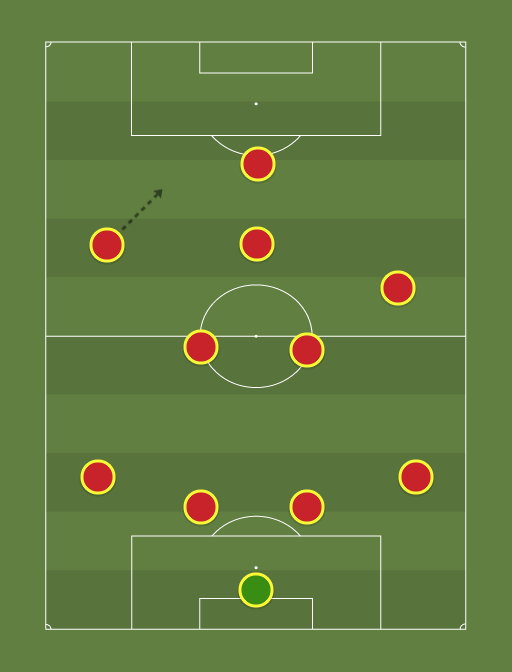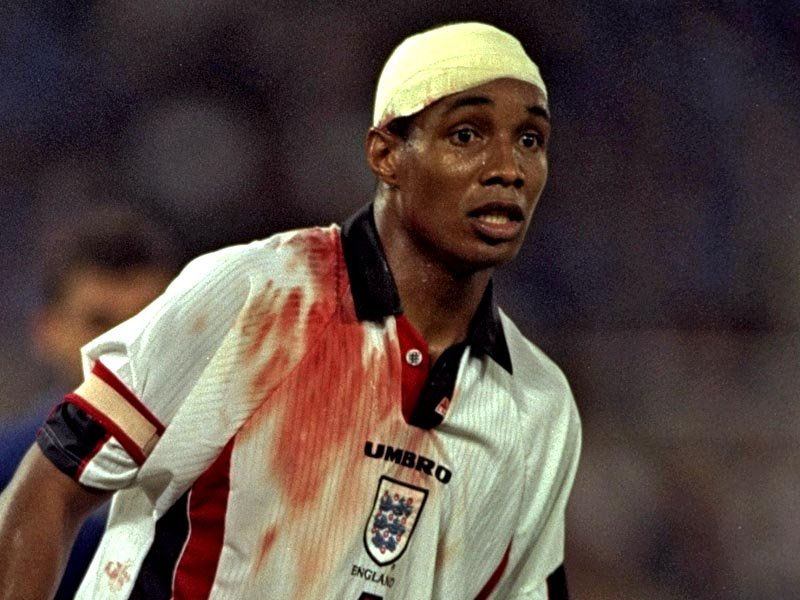----------------------------Team Skizzo/Pat--------------------------------------------vs--------------------------------------Team Chesterlestreet


Skizzo/Pat's tactics -
Chester's tactics -


Skizzo/Pat's tactics -
We’ve drafted exclusively from players who peaked in the post-1955 period following the advent of the UEFA club competitions. As a result we’ve assembled a squad with cast-iron credentials and pedigree at an international level. Of our starting XI, we boast no less than 7 European Cup/CL winners. 10 of our squad have won a European club trophy, and of the others, John Charles is a multiple-time Scudetto winner and Bobby Moore a World Cup-winning captain. We change our line up from a 4-4-2 to a lopsided 4-2-3-1, with the unlucky Ian Wright making way for Lampard. Lampard provides the extra man in midfield whilst still offering a prolific goal threat, and Bobby Lennox retains the exceptional pace to stretch Chester’s defence. Lennox will be slightly more advanced, ready to feed off Charles’ knockdowns and stretching Chester’s defence. Beckham will do as Beckham did, dropping deeper or infield to make Utd’s 4-4-2 work against elite opposition, and finding Charles with arguably the most consistent source of quality crosses in history.
Defence:
We field one of the all-time great British goalkeepers in Neville Southall. In front of him, Moore and Lawrenson form arguably the best centre-back pairing in the draft. Similar in dynamic to the great Hansen/Lawrenson partnership, Moore commands the defence with his peerless reading of the game, impeccable timing in the tackle and great distribution. Lawrenson complements him with his superb recovery pace and strength in the air. Flanking them are two of Utd’s greatest ever full backs.
Midfield:
The lynchpin of our midfield is “the beating heart of the Lisbon Lions” Bobby Murdoch, one of the very best midfielders in the draft. A combative ball-winner, a wonderful passer and a true leader, he is partnered in central midfield by the fiercely competitive Paul Ince. On the flanks, one of the most unerringly brilliant crossers of the ball ever in David Beckham, and the scintillatingly fast Bobby Lennox, who was putting up almost Ronaldo-esque goalscoring numbers from the wing nearly 40 years before we’d ever heard of Ronaldo. Rounding out the midfield is Frank Lampard, with his excellent work-rate, underrated eye for a pass and indisputably brilliant eye for goal. If he thrived off Drogba’s knockdowns, he’ll be in heaven feeding off of John Charles.
Attack:
The legendary John Charles is arguably the best centre forward in the draft, with a brilliant goalscoring record, near-unstoppable ability in the air, and the rare distinction of being well-rounded enough to be world-class both as an attacker and a defender.
How The Game Will Be Won:
John Charles will be the match winner here. Billy Wright was a fine footballer and by all accounts had a prodigious leap, but an aerial duel between a 5’ 8” centre back and Charles is only going to end one way. Woodburn, from what we can gather, was a good but unexceptional centre back who isn’t going to thwart Charles either, and his notorious temper will be tested against the physically incredible Charles. With Beckham’s delivery, he’ll be in his element, both scoring himself and assisting the incredible threat from Lennox and Lampard, arguably the best goalscorers from their respective positions in the entire draft.
Where Chester’s team excels is in midfield. Edwards and Crerand are an exceptional partnership. Even as a 21 year old, we’re willing to accept Edwards’ brilliance, but Ince has the athleticism, willpower and technique to at least be competitive against any midfielder in the draft. Beside him, Murdoch is simply exceptional. “The beating heart of the Lisbon Lions”, he’s both a playmaker and a warrior, with a proven ability to exert his influence against teams of the calibre of 1967 Inter Milan. Supporting them are Beckham and Lampard, with their freakish stamina and proven ability in similar systems. It’s a serious leap of faith to assume that the likes of the Jacksons, Haynes and Shackleton will be equally capable of supporting their midfield off the ball.
Chester is also extremely strong in attack and we can’t hope to stifle that completely, but we have an all-time great goalkeeper in Southall, a defence comprised of 3 European Cup winners and a World Cup winning captain, and possibly the greatest and most complementary centre back pairing in the draft.
Chester has assembled a great team, but ultimately our team has proven their ability on the higher stage. No-one knows whether the likes of Woodburn, Jackson x 2 and Bastin could have adapted to the modern game or demonstrated their talents at a world class level. There’s no such question marks about our lads, who have 8 European Cups, a World Cup, 3 Scudettos, and 3 European Cup Winners Cup medals to their name.
Chester's tactics -
What I'm going for here is a variation on the 4-2-4, the formation most commonly associated with the great Brazil side of '58. There are distinct differences, however, between my take on this classic formation and the Brazilian model. Matt Busby favoured the 4-2-4 too – and if anything my variation resembles his Manchester United more than Brazil, whilst not using either side as a blueprint. It's a specialized 4-2-4 with certain key elements.
Perhaps the most important of these is the role of Johnny Haynes. As the arrow (who doesn't love a good arrow?) indicates, Haynes will drop deep here – and he will do so regularly. This will allow him to use his passing range to the fullest: In what we may call the second striker position which is his default one (and which reminds us of his younger, inside forward incarnation), Haynes' main function will be that of hitting the ball short, at Dean in the middle – but not least at the ghost-into-the-box wingers, both of whom excel at precisely this sort of game: Bastin and Jackson are high scoring wingers who like nothing better than to get on the end of a through ball from a withdrawn forward: What you get here – with due respect to the great man – is an upgrade on the famous James-to-Bastin-and-into-the-net formula which was so effective for Arsenal; an upgrade I say, because Johnny Haynes is an even more clinical passer than Alex James.
Haynes' other function, however, is as stated above to drop deep, which is perfectly natural for him: He drops down further into the hole, so to speak, taking up positions from where he can ping long balls out to the wingers – who will then, simply, seek to cross: The opposite winger drifts (or rather runs, hopefully – no sense in jogging about sluggishly) into the box to join the man many consider the most dangerous header of the ball in the history of the game. Ideally, Edwards has made one of his runs at the same time, while Haynes drifts (runs!) back into his default space and beyond, leaving the opponent to deal with four men in the box as Bastin or Jackson takes aim from out wide. Well worth to note here that Dean isn't just a direct threat in the air, but an indirect one too, as it were: Heading the ball down for Jackson or Bastin (or anyone else who has managed to get into the box) is a very plausible alternative, should he be unable to finish directly.
Should be a goal or two in there somewhere.
Addendum on Dean: While being something of an ultimate goal getter, Dean has qualities which are seldom highlighted but nevertheless characteristic of his game: He was very good at setting up his team mates with short, precise passes – which will give Bastin and Jackson an alternative to the Haynes through ball: They can play their ghost-into-the-box game with both Haynes and Dean being second-to-last on the ball. This obviously isn't Dean's main feature as a player – he is there to finish, first and foremost – but it's a quality of his which will come in handy on top of his finishing.
Roles of central midfielders: Edwards plays a box-to-box role, Crerand holds. The latter's role is very similar to the one he often played for Busby: Fairly conservative as such. Crerand, however, is an excellent passer, which comes in handy when building up attacks. Edwards' role is much freer – he operates box to box, using both his incredible physical presence and his brilliant on-the-ball skills as required, where required.
Defence: Marshaled by Billy Wright, they defend. That is their main function here. The attacking part is well taken care of by others. Two things to note, however: Byrne is more than capable of venturing forward a bit, should the occasion arise. And Woodburn likes to carry the ball out of defense, as the build-up begins: This is an important feature of his game – so I won't deny him the chance to showcase it here. He's a ball playing sort of defender, much before his time in that regard, which makes him an ideal foil for Wright. Pat Rice is a no frills, ultra dependable fullback. He will go quietly about his business here, staying tight on whoever he's marking, focusing on the defensive side of things.
In short:
It's an offensive approach, decidedly so. I plan on outscoring the other guy and I'm not overly concerned should he manage to grab a goal. Grinding out 1-0 wins is clearly a waste of my players' talents anyway. Still, for those who immediately think a 4-2-4 formation is too ultra offensive to stand a realistic chance, I point again – as I did to begin with – to Haynes' role. When he drops, as he will all the time, the nominal formation becomes either a 4-2-3-1 or a 4-3-3 of sorts. Haynes isn't a striker but a playmaker, so keep that in mind.

 He's a rogue alright!
He's a rogue alright!
